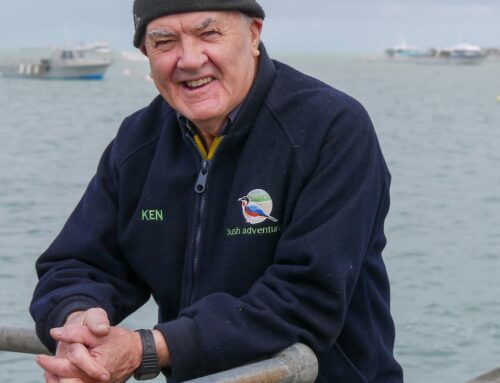More than 80 years ago, Morgan Feast’s great-great-grandfather set out to dig a drain on the family farm with the aid of only some shovels.
The drain is fed by a karst rising spring, an impression of groundwater to the surface found throughout South Australia’s Limestone Coast.
The Feasts’ farm at Wye has used this drain to help feed its stock ever since it was dug.
But for the first time, the drain has run dry and has been without water for months.
“Our biggest worry is the toxicity of the stock water,” Mr Feast said.
“We’ve had a fair few tests done and salinity levels are pretty high in our [feed] troughs.
“If they get too high we won’t be able to run stock in those paddocks or on the farm at all.”
The Feasts’ farm draws its water from the wide-ranging groundwater system sitting below the surface of the Limestone Coast.
The system is comprised of deep and shallow aquifers, carved out in limestone across thousands of years of groundwater movement.
Water levels are recharged by rainfall, as well as in smaller amounts by irrigation water re-entering the system.
Morgan’s mother, Jo Feast, is worried the dry drain at her property is a sign the water resource is declining.
“I think the whole region needs to stop and have a look at what’s happening down this way and ask why it is happening,” she said.
Region’s groundwater ‘over-allocated’
The way the region’s groundwater is used is controlled by the Limestone Coast Landscape Board, which puts in place an allocation plan for the region.
Planning and engagement manager Liz Perkins said officials had visited the Feasts’ farm to inspect the drain, which is in an area where the board is worried about water levels.
“During the winter it rains and the groundwater levels recharge,” Ms Perkins said.
“And [in summer] even without extraction, groundwater levels will decline because it’s hotter.
“By the time we get to autumn we expect to see our lowest groundwater levels, and what happens with extraction, we can see those lows are a lot lower.”
The board is reviewing the Lower Limestone Coast Water Allocation Plan before locking in changes next year.
Ms Perkins said the decade-old plan was over-allocated.
“We’re 10 years on since the plan came in, we’ve got better data, information and science and we have a better understanding of what’s happening with our groundwater resources under the current use and allocation,” she said.
“There is a need to consider what is a sustainable allocation looking forward and also consider climate change in that as well.”
Ms Perkins said the board was expecting climate change to cause longer dry periods and more extreme wet periods, meaning the plan needed to be flexible.
Industry questions water data
A range of industries, including forestry, dairy cattle, viticulture and agriculture, rely on the Limestone Coast’s groundwater to operate.
SA Dairyfarmers Association (SADA) chief executive Andrew Curtis said cuts to water allocations would have a negative effect on the industry.
He said other initiatives, such as alterations to drainage systems, should be tried before cuts were made.
“Our strength is our ability to irrigate to supplement the rainfall we receive in the lower Limestone Coast,” he said.
“Cuts in available water will have a direct impact on our ability to produce milk, to milk cows, to feed cows and therefore on our businesses.
“There’s a direct correlation between the size of the industry and the available water.
“We are really conscious of not overusing water and all our farmers work very stringently to only use the water that they need.”
Mr Curtis said the SADA was concerned the data used to inform the allocation plan was out of date.
In response, Ms Perkins said the data being used as part of the review was from 2023 and was updated regularly.
‘Societal value’ of water part of debate
Flinders University hydrogeology professor Adrian Werner and his research team have developed a program that allows real-time water levels across the region to be monitored and compared against historic levels.
Professor Werner said the system was complex and water levels in specific areas varied due to a range of factors, including land use and rainfall levels.
But he said there were areas where groundwater levels had gradually declined over the past 20-30 years.
Professor Werner said deciding whether a groundwater system was over-allocated was complicated.
“Whether something is over-allocated or not depends on the societal value of the water and society’s view of the ecosystems and the best value for that water,” he said.
“There are principles there that go beyond looking at the groundwater science.”
The landscape board will meet with landowners, industries and researchers over the next year.
But the Feasts are worried the longer it takes to change the plan, the more uncertain their future will be.
Mr Feast said he did not want to cut down on stock numbers, but may have to in the near future.
“Every day you need to keep farming, you can’t let it get to you too much, but we’ve got to act on it pretty soon,” he said.
“I would love to keep the farm going for generations to come.
“I’m the fifth [generation] and [after] all the generations before me, for it to possibly stop now for a massive emergency … it would be pretty upsetting to lose it right now as I’m starting to take it on.”
Get our local newsletter, delivered free each Friday




